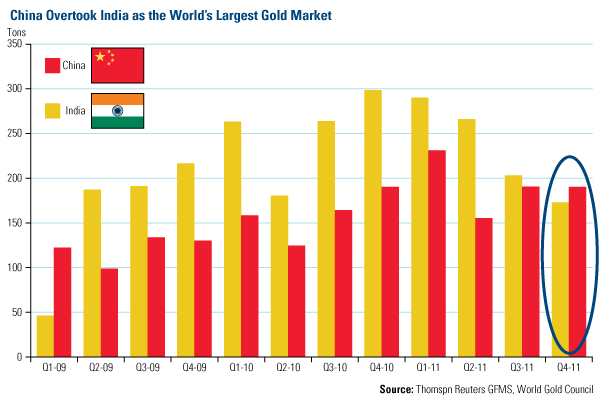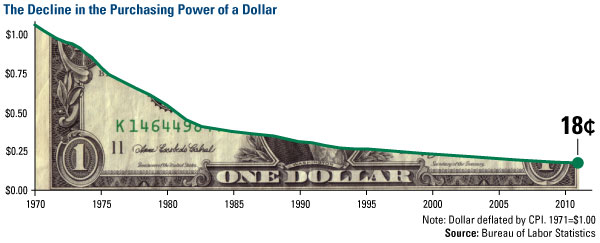The World Gold Council (WGC) reaffirmed the power of the Love Trade in its 2011 Gold Demand Trends report released this week. Gold demand grew 0.4 percent in 2011 despite a 28 percent year-over-year increase in bullion’s average price.
After flirting with the top spot for some time, China emerged as the world’s largest gold market for jewelry and investment during the fourth quarter of 2011 as demand in India weakened. This is the first time China’s demand outpaced India’s in 11 quarters. However, India did retain the gold demand crown for the entire year, purchasing 933 tons compared to China’s demand of 770 tons.

I always say the trend is your friend, and I believe China’s increasing demand for gold is one trend that is just getting started. Although gold imports from Hong Kong were cut in half in December, HSBC Global Research reports that overall gold imports from Hong Kong were 10 times the historical average from January through November 2011. HSBC expects a continued rise in Chinese incomes will keep demand at a robust pace. The WGC sees domestic demand for gold jewelry and investment driving 20 percent growth in Chinese gold demand during 2012.
China should consider its leadership as the No. 1 gold market a short-term position, though. While China’s presence in the bullion market is strong and growing for jewelry and investment, India’s ancient relationship with the yellow metal is such that “domestic drivers of demand are largely independent of outside forces,” says the WGC. The WGC does not see India’s role in the gold market diminishing over the long term.
Ajay Mitra, the WGC’s managing director for the Middle East and India, recently expressed India’s strong ties with gold in a 60 Minutes feature. Gold has always been a part of India’s history, culture and tradition. I have witnessed firsthand the strength of this bond many times over the years. As the famous saying goes, “no gold, no wedding.”
Don’t Forget About the Fear Trade
The Fear Trade was also recently reaffirmed by the Federal Reserve when it publicly stated its intention to keep inflation at “exceptionally low levels” through 2014. Inflation is the kryptonite to the Fed’s monetary efforts and it’s likely the Fed will take any measures necessary to prevent inflation spikes.
The Fed has targeted a 2 percent inflation rate, which means the U.S. dollar will lose 33 percent of its value over the next 20 years, says The Daily Reckoning’s Charles Kadlec. In the next four years alone, nearly 10 percent of the “value of Americans’ hard earned savings” will be destroyed, says Charles. Put another way, Charles estimates that it will take $150 in the year 2032 to purchase the same amount of goods you could get for $100 in 2012.
For four decades following the end of the gold standard, the purchasing power of the dollar has been plunging: A dollar worth 100 cents in 1970 is now valued at a measly 18 cents.

Charles isn’t the only one opposed to the Fed’s “monetary manipulation.” In his latest letter to shareholders, Warren Buffett faults the government and its “systemic forces” for destroying the purchasing power of investors. He argues stock investments offer the best long-term investment opportunity because interest rate levels don’t offset the loss of purchasing power due to inflation.
However, there is one group that benefits from the low interest rate environment—borrowers. This means the largest borrowers in the world, developed world governments, will be able to service their enormous amounts of debt more easily. This year alone, the U.S., Japan and Europe will roll over $8 trillion in federal debt.
CIBC World Markets sees the secular bull market in gold continuing for “several years,” as the firm believes debt in major economies has reached a point “where financial and economic pressures will manifest themselves in ways that have up until now only been dreamed about.” With these manifestations, Ian McAvity equates gold to insurance. He suggests to readers that they wouldn’t cancel fire insurance because their house hasn’t had a fire. “Gold proffers the best ability to protect long-term purchasing power against deliberate devaluation of the paper alternatives,” he concludes.
From the article, “The Enduring Popularity of Gold” by Frank Holmes. Frank Holmes is chief executive officer of U.S. Global Investors – a registered investment adviser that manages approximately $2.8 billion. The information provided herein has been provided to MiningFeeds.com by the author and, as such, is subject to our disclaimer: CLICK HERE.



 Follow us on Twitter
Follow us on Twitter Become our facebook fan
Become our facebook fan











Comments are closed.